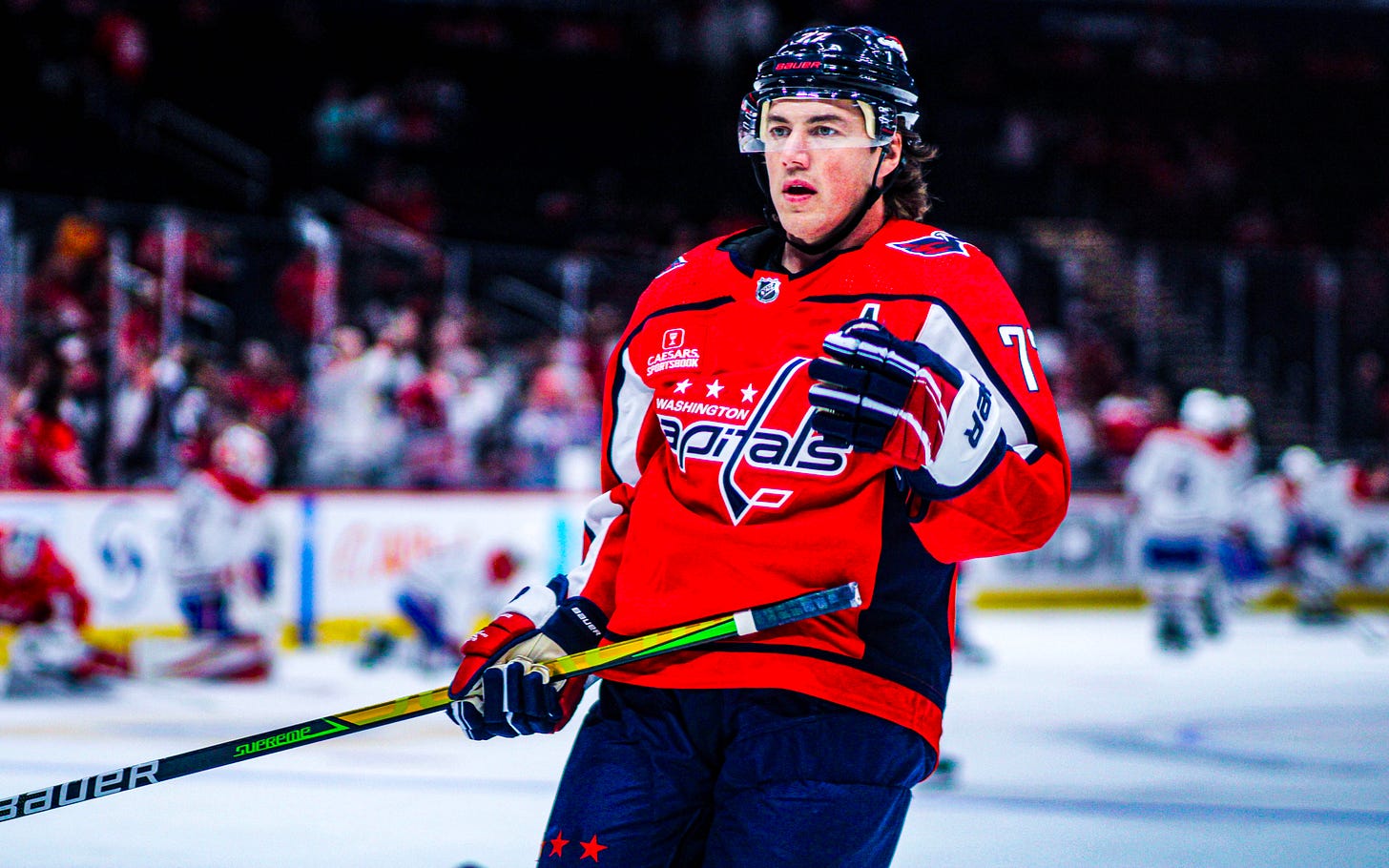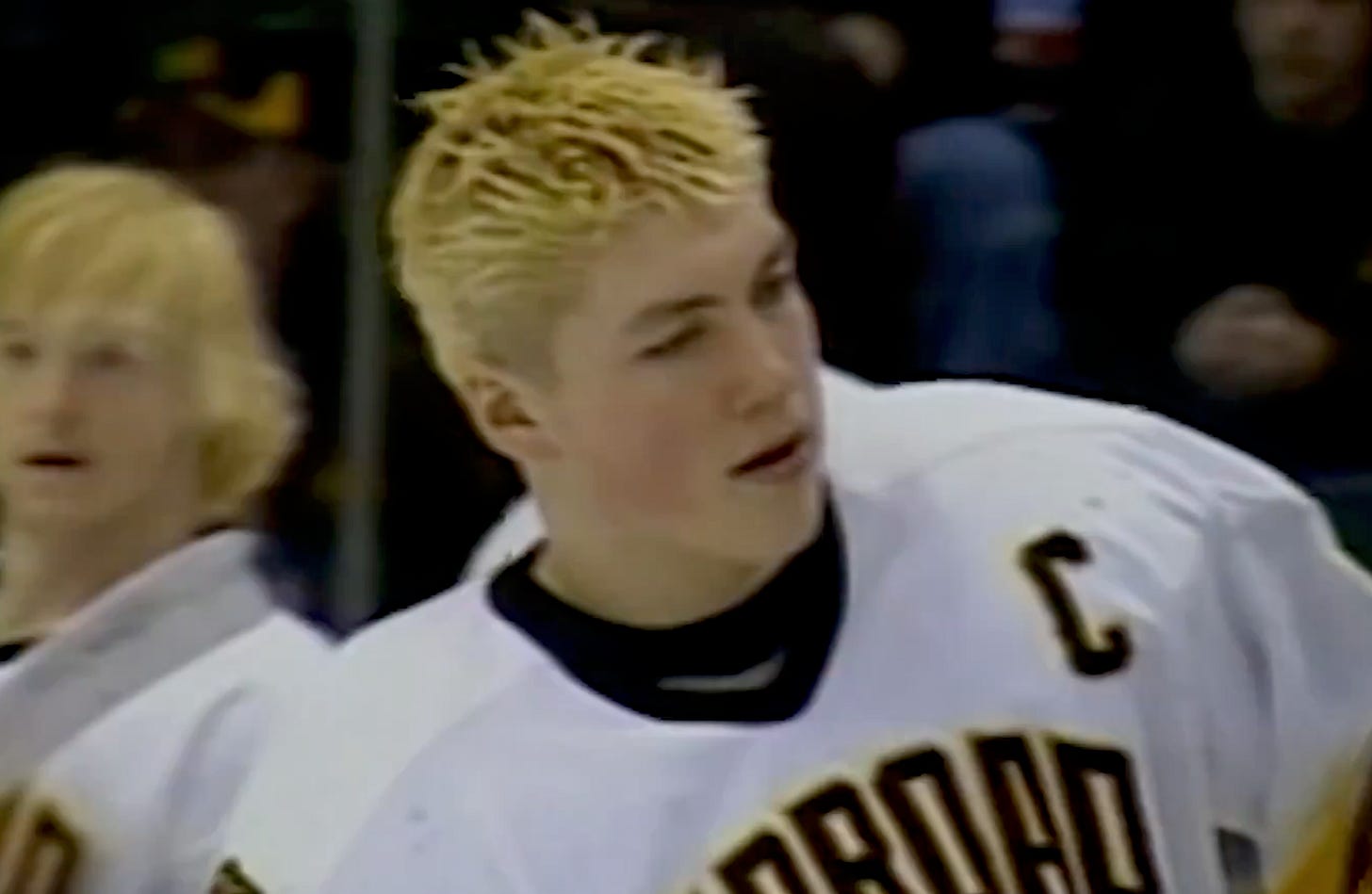How T.J. Oshie Became... Well, T.J. Oshie
Looking back at the Washington Capitals legend's iconic career and how he found his identity after 16 NHL seasons.
WASHINGTON — T.J. Oshie never played for the name on the back. But as the Washington Capitals forward hangs up the skates, the name “Oshie” has become synonymous with “warrior,” “motor,” “icon” and “legend.”
Go up to any of his teammates, and they’ll describe Oshie in a similar vein, citing the relentless energy and enthusiasm that kept him coming back to play night after night despite debilitating back pain that would make it nearly impossible to move.
Coach Spencer Carbery recalled the morning of his 1,000th NHL game. It was March 16, 2024. The Caps were taking the ice for morning skate, and Oshie couldn’t move.
“It was going to be a big moment… all through the afternoon, what a lot of people don’t know is he’s trying to do everything he possibly can to get his body in a position where he can play a game at 7 o’clock that night,” Carbery said. “Think about his teammates when they walk away from the rink and they see this guy show up at 5 o’clock and he’s about to play game number 1,000.”
It took a village — almost quite literally — for Oshie to be able to battle through and make it onto the ice night after night. Hours of stretching and preparation and dedication from trainers, along with Oshie’s hunger to play, made it possible for Oshie to get to the finish line and cap off a historic career in 2024.
But how did T.J. Oshie become T.J. Oshie, the player that “gave everything I had” to the game every second he was on the ice?
It started in Everett, Washington. His father, Tim, who’s affectionately called “Coach,” introduced Oshie to the game at a young age. But Oshie wasn’t able to truly embrace it.
The closest rink was 45 minutes away.
It all started when Oshie was just a kid from Everett, Washington. His father, Tim, who ran a roller rink in Seattle, coached him and helped him fall in love with the game. He constantly stressed the following quote to a young Oshie, which he still carries with him: “Today, I will give all I have for this moment. It may never come again.”
However, it wasn’t that easy.
Finding ice time in Washington State at the time was difficult. Hockey was expensive, and the closest rink was 45 minutes away. His practices were twice a week, with ice time beginning around 9-10 p.m.
“It was rough for me as a kid… super, super difficult,” Oshie said.
But Oshie loved the game, and he wouldn’t give up. So he and his family commuted up early, Oshie skated, got picked up and often made it home around 2 a.m. before having to get up for school in the morning. On the weekends, they’d venture to Canada for more ice time and opportunity and tournaments.
There was a solution, though, a life-changing moment that would transform Oshie, a mediocre skater at the time, into a star in the making: a move to Warroad recommended by his cousin Henry Boucha.
"I had some skill back then, but I wasn't a great skater prior for lack of being on the ice. So when I went to Warroad, that's when my skating improved... I started making strides," Oshie recalled.
Warroad, known as HockeyTown USA, is a mecca for the game. You can find an ice sheet just about anywhere, and Oshie went from late-night skates twice a week to spending six-plus hours on the ice a day.
The move brought Oshie to life, both as a player and as a person. Fittingly, his Native American name, “Keeway Gaaboo,” that he earned at his first powwow in Warroad, translates to “coming home.”
"I learned a lot of my manners and how to treat people and talk to people," Oshie said. "My family is very good at that. But especially in Warroad, Minnesota, everyone's like that," Oshie said. "So now only that, my first year there, I skated every single day that the ice was in, so that's 180 days or so straight of me being on the ice, which was absolutely amazing."
Oshie became a star player for the Warroad Warriors, leading his high school to three straight tournaments and titles while breaking record after record. It didn’t take long before he was a household name and a promising NHL prospect.
Then, in 2005, while watching MTV’s The Real World at friend Eric Olimb’s house, he found out — thanks to Olimb’s dial-up internet — that he was a first-round NHL pick, going to the St. Louis Blues 24th overall.
The rest is history.
"I just imagined that I'd always play hockey, and that's kind of where my dream ended," Oshie said. "My dream was to just score the game-winning goal in overtime, and that was kind of what I did every day in the backyard, and that was it. I was never stressed out about what I was going to do when I grew up; I kind of had my mind made up that I was just going to play hockey, and that was it. There was no other option."
Oshie played in St. Louis for seven years and also made headlines as an Olympic hero in 2014 after scoring four shootout goals to lead Team USA over host Russia in 2014, but he couldn’t help the team get to where it wanted to be.
All the while, Washington was looking to acquire a star right winger for Alex Ovechkin and Nicklas Backstrom. Enter Oshie, who was acquired in a blockbuster offseason trade on July 2, 2015.
“At the time, there was a feeling like I let down a city and an organization, being on so many good teams and never finding a way to win the Stanley Cup. I was nervous, scared. How could I leave a team of trainers, players and fans whom I love so much? I’d say that weight was with me probably for the rest of the summer. Most of that weight was lifted a couple of minutes after my call with (Blues GM) Doug Armstrong, when I got a call from Capitals GM Brian MacLellan,” Oshie recalled on Monday. “Mac, you’re a man of few words, but in just minutes, you made me feel how excited the Capitals were to have me. Thank you for your belief in me. It changed my life.”
It was with Washington that Oshie became “Sevens,” the lovable right wing that will go down as one of the best to wear a Capitals jersey. His drive and energy were on display night after night, whether he was jumping off the ice, running down the tunnel and kissing the team’s Stanley Cup poster after warmups or finishing off a tic-tac-toe passing play in the “bumper spot” on the power play.
"I didn't really dream about people wearing my jersey, you know?... It's a game I love and still love today," Oshie said. "All the support and fans wearing my jersey and recognition, it's unbelievable. Teams I've been on, that's just a bonus. My dream was just to play hockey forever."
Oshie truly did it all. He could drive down the right side and make a highlight-reel play before feeding his teammate for a picture-perfect tap-in. He could deliver a big hit, as he showed rookie Adam Fantilli. He could turn a team into a championship franchise, as he did when he put up 21 points in 24 playoff games and served as the heartbeat of the Capitals locker room en route to its first Stanley Cup in 2018.
“The way he plays, you cheer for the guy and his character,” MacLellan said of Oshie.
As the 38-year-old calls it a career, he said it’s hard to put into words what it’s meant to become a staple in the District, where he played for nine years while racking up 385 points.
"I like to think that when I was playing, I was playing for my teammates, for my coaches, for my family, for my fans. I rarely thought about my own accolades," Oshie said. "To be remembered that way is a huge honor, because that was my goal and the way I played the game."
Every moment has made Oshie into the player he is, and the player he’ll go down in history as. Now, off the ice, he’s focused on being a family man, a loving husband and father, and free of back pain. Entering the next chapter, he wants to stay in hockey, and hopes he and the Capitals can figure something out.
For now, though, he’s officially calling it a career — and what a career it was.
“To my family, friends, coaches, trainers, teammates, fans and to the game of hockey, I can promise you this: the moment my skates touched the ice, I gave you everything I had,” Oshie said proudly.




